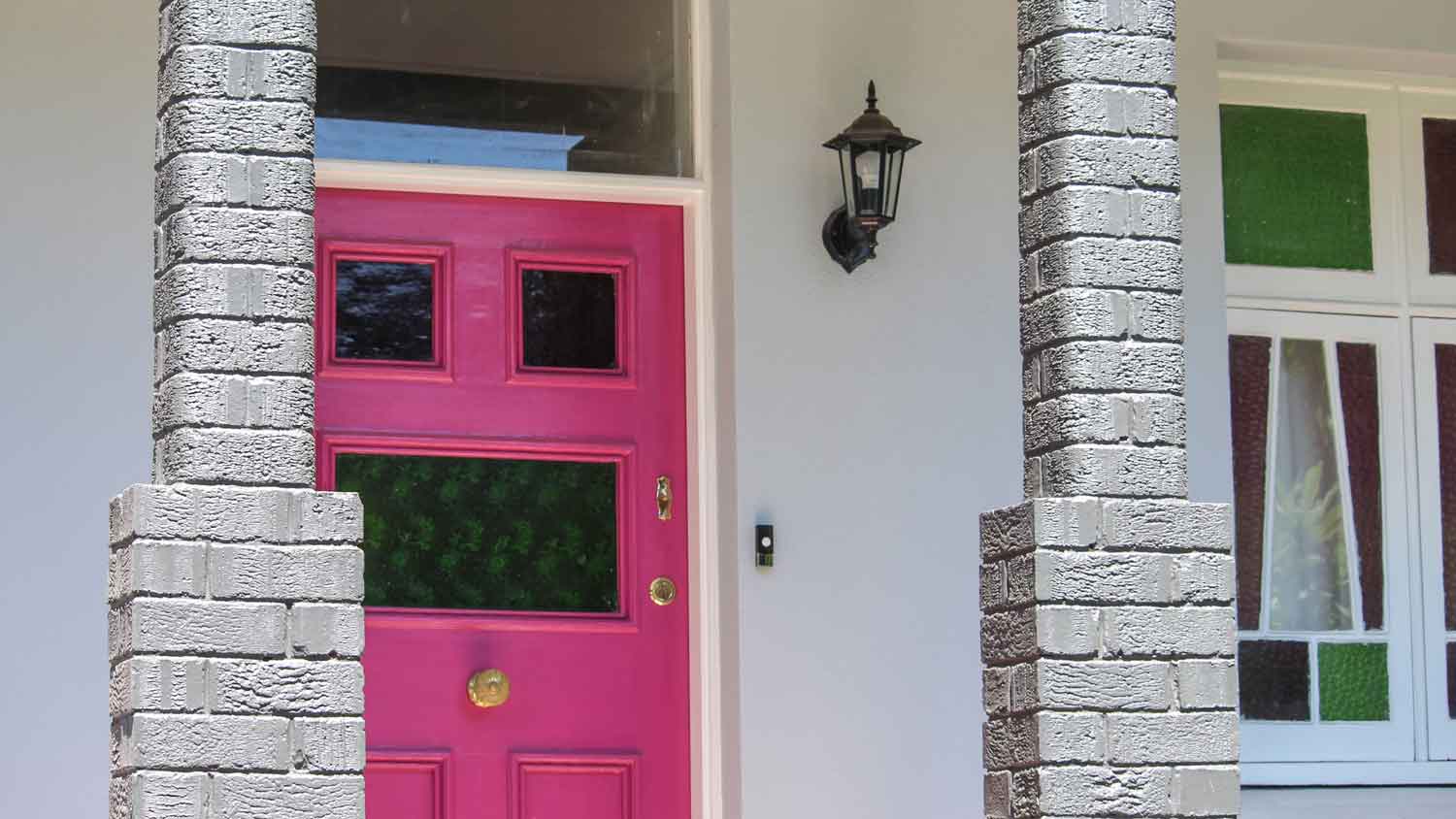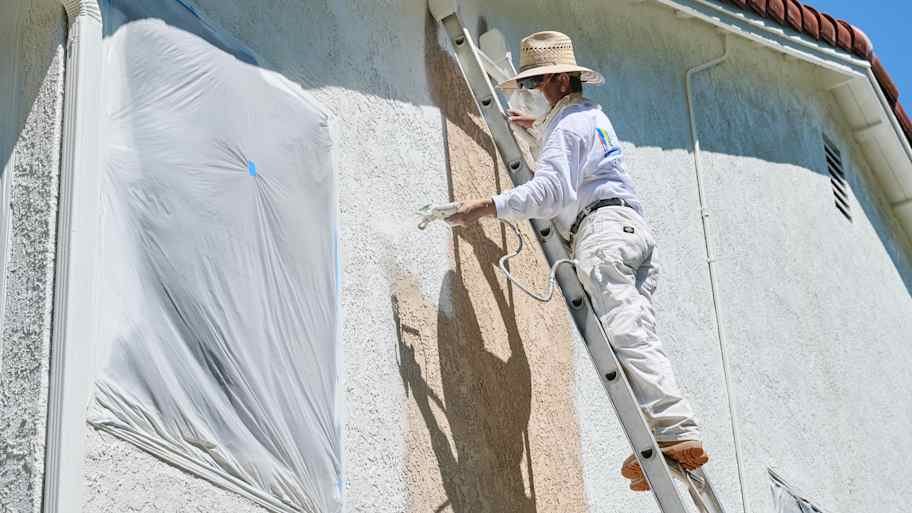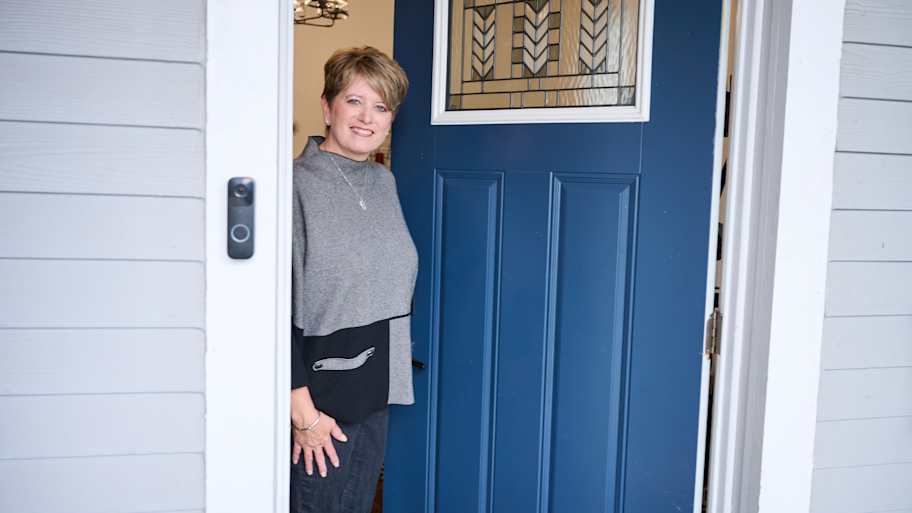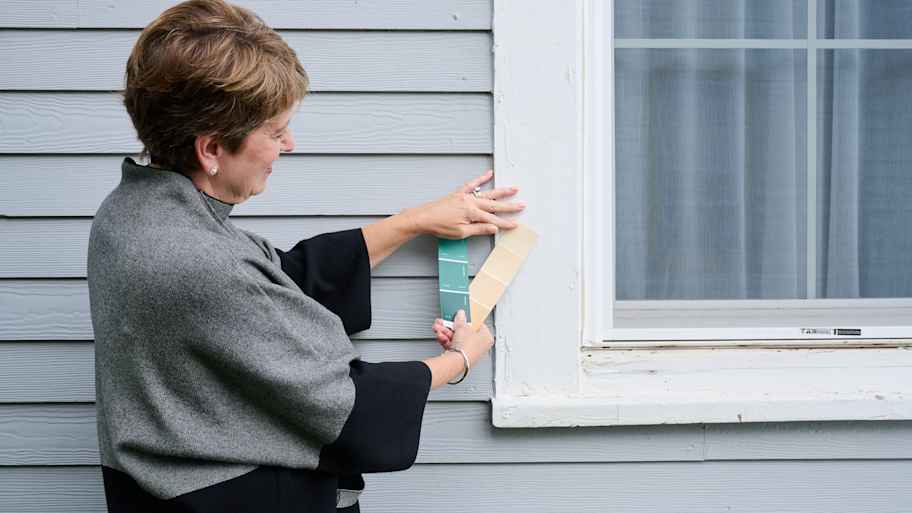The Best Paint for an Exterior Fiberglass Door
Hues you can use


Whether it’s at the front of the house or the back, an exterior door stands as a focal point, exerting serious influence over the visual appearance of your home. Choosing the right color and base is crucial in bringing together the design of a house and helping it maintain its glorious appearance for years. That’s why we’ve rounded up the top paint colors and the best paint for exterior fiberglass doors you should buy.
Choosing the right color for your exterior fiberglass door requires you to consider many different factors, including the architecture, the colors of the siding and trim, the appearance of your neighbors’ homes, and the region in which you live. The eight colors explored below offer a range of options fit for fiberglass exterior doors on every kind of house.
But before you dive in, make sure you really want to do this project yourself. Your door gives the first impression of your entire home, so making even a small mistake would dash your dreams of that perfect entryway. You can learn how to paint a door yourself if you want to make it a DIY project, or you can hire a local exterior painter for a great result. If you leave it to the pros, the average labor cost for painting exterior doors ranges between $25 and $100 per hour.
Best Types of Paint for Fiberglass Doors
Don’t dive into the fun of color selection just yet. It’s important to first consider which types of paint will perform the best on the outside of your fiberglass door. The synthetic material makes for doors that stand up to the elements for longer than wood, and while they’re not difficult to paint, exterior fiberglass doors fare better with certain bases and finishes over others.
Base
As is the case for many home improvement projects, latex (or water-based) paint is the best paint for exterior fiberglass doors. It’s safer and friendlier to the environment than oil paint and performs better on the material. Make sure to get exterior paint, which is formulated to resist mildew and fading better than interior paint.
Finish
Durability is the most important factor in selecting exterior door paint. A semi-gloss finish will maintain its appearance for longer than other options when exposed to the elements. It will also mask imperfections better than a high-gloss finish, and it’s easy to clean—important considerations for this high-utility piece of your home.
Best Paint Colors for Fiberglass Doors
Once you’ve chosen the best type of paint for a fiberglass door, it’s time to start thinking about which colors will pair best with the exterior house features you already have in place. Though you might not think that door color is that important to the overall color scheme, you’d be surprised at how much of an impact it can have on everything from your shutters to your siding. Keep reading to determine which shades consistently deliver the best results on fiberglass doors.
1. Red

Now that we’re on the fun part, why not start bold? If you want your exterior fiberglass door to pop with color without being too ostentatious, consider red. One of the most popular exterior door shades, red tones are familiar enough to appear somewhat neutral while still providing some additional visual interest.
A coat of red paint can seamlessly integrate the front door with the rest of your home’s design as well as establish eye-catching contrast. A deep brown or purplish red, like burgundy, for example, can draw out the brightness of red brick, while a softer, lighter red can match the crisp simplicity of clean white siding.
For inspiration:
Benjamin Moore® Ryan Red
PPG Binge Watch
Sherwin-Williams Bravado Red
BEHR® Red My Mind
2. Gray

The English language rudely takes “gray” as a synonym for “boring,” but this beautiful in-between color has such a wide range of subtle variations that it can fit many different styles of exterior fiberglass doors.
A gray door will blend right into homes with stonework and lots of neutral shades, but it can also serve as a vivid statement on a bright home with white siding. Not to mention, it’s an excellent way to tone down brighter statement hues like yellow exterior house paint colors. Gray paints come in a few different broad undertones that pair well with many different colors, but it can be difficult to match to brown or wood siding and windows.
For inspiration:
BEHR® Half Sea Fog
Sherwin-Williams Aloof Gray
Kelly-Moore Platinum Granite
Backdrop Italian Plaster
3. Black

A black front door can be striking and simple at the same time, adding a distinctive dash of personality while leaving room for the other elements of your home’s exterior to speak for themselves. It’s also likely to up the curb appeal for potential future buyers.
Carrying its unmistakable aura of sophistication and elegance, black is especially suited to classic design styles on homes that receive lots of natural light. It also pairs well with more rustic hardware finishes, like a brass door knocker. Add a white trim to really make your black fiberglass door pop.
For inspiration:
Farrow & Ball Pitch Black
Sherwin-Williams Tricorn Black
Benjamin Moore® Black
Valspar® Dark Kettle Black
4. Navy Blue

Navy blue is a popular choice of exterior door color among today’s DIYers, offering rich depth and unshowy style. This cool, classic shade can provide visual interest while remaining somewhat neutral, providing the perfect accompaniment to organic design styles.
Grayer, lighter navy tones are more subdued, making them a versatile choice that can mesh with many different home styles. Deeper, darker navies will appear quite dramatic unless paired with a similarly rich siding color.
For inspiration:
Benjamin Moore® Deep Royal
Sherwin-Williams Dark Night
Benjamin Moore® Marine Blue
ECOS Star-Studded
5. Green

DIYers can achieve many different kinds of effects with a green exterior door. Deep shades of green perfectly complement a surprisingly diverse array of construction and design styles. Brighter, more yellowish hues can make for a bold and cheeky statement door on the right home.
Rich greens with brown undertones can be used to integrate a door with the surrounding landscape. Muted, deep, or more neutral shades of green on a door can add a personal touch that’s still tasteful and inconspicuous. The opportunities really do feel endless with green.
For inspiration:
Benjamin Moore® Lafayette Green
Dunn-Edwards Ivy Enchantment
Sherwin-Williams Laurel Woods
Valspar® Sparkling Sage
6. Blue

While navy shades are most common on exterior doors, there’s a whole world of blue to draw from when designing your entryways. Cooler, more neutral teals are right at home on a farmhouse, while nothing says beach town like a bright aqua door. Electric blue can make for a vivid accent door, and whiter, medium blues echo the color of the sky and provide a calm, relaxing vibe.
For inspiration:
Dunn-Edwards Dockside
Glidden® Electric Blue
Clare Summer Friday
Sherwin-Williams Peacock Plume
7. Yellow

Warmer yellow and gold hues can give an exterior door a sunny, homey feel. Dark shades evoke a sumptuous elegance, while medium yellows achieve an organic effect. If you’ve got an appetite for vivid, eye-catching design choices, bright, citrusy yellow exterior paint can pop in a way that puts a smile on any visitor’s face. Yellow is especially well-suited to minimalist homes with white siding.
For inspiration:
PPG Banana Brulee
Dunn-Edwards Lemon Macaron
Sherwin-Williams Golden Plumeria
Benjamin Moore® Stuart Gold
8. Pink

A pink door isn’t for everyone, but it could be right for you. More saturated pinks add a fun and flirty touch, whether it’s a coral tone on the door of a blue beach house or a bold hot pink door that stands in contrast to more neutral siding. Lighter, more muted hues like salmon are tasteful and classic while still flashing a little personality.
For inspiration:
Clare Pink Sky
Sherwin-Williams Charisma
Benjamin Moore® Spring Azalea
Sherwin-Williams Smoky Salmon
Paint vs. Stain for Exterior Fiberglass Doors
Whether you paint or stain an exterior fiberglass door depends on your preference. Paint creates a smooth, uniform appearance that masks defects and textures. However, if you want to highlight the textures of your door or alter its appearance to resemble something else, like wood, consider using stain instead. One practical upside to painting over staining is that it will provide more protection and last longer, especially if your door receives extended sunlight exposure.
C.E. Larusso contributed to this article.
Frequently Asked Questions
Because of its chemical composition, you don’t need to prime fiberglass before painting. Paint will adhere without issues and have a smooth, even appearance without needing a primer coat. However, a top coat may be necessary to limit damages from weather and ensure you don’t need to repaint your door so soon.
With a protective top coat, fiberglass door paint will last two or more years. Sometimes, this life span can be even shorter depending on what elements the door is exposed to. Conditions like heavy rain and snowfall don’t usually cause issues, but high temperatures and direct sunlight can quickly lead to cracking and bubbling.
Paint adheres more easily to fiberglass than other materials, and so do brush marks. Using a brush can result in an uneven texture and patchy appearance, especially when using a quick-drying paint like latex or acrylic. Instead, use a foam roller to ensure the paint is evenly and consistently applied.





- 7 Brilliant Front Door Colors for a White House to Make Your Abode Stand Out
- 10 Front Door Colors for Red Brick Houses That Bring Home Class and Style
- How to Paint a Door and Give It New Life
- Fiberglass vs. Wood Door: Which Is Best for Your Home?
- How Long Do Front Doors Last?
- The Best Vinyl Siding Paint Colors to Elevate Your Curb Appeal
- 9 Garage Door Paint Ideas to Elevate Your Home’s Exterior
- 8 of the Best Front Door Colors for a Brown House
- The Best Color Choices for a House With a Brown Roof
- 7 Simple Tips To Update Your Front Door















